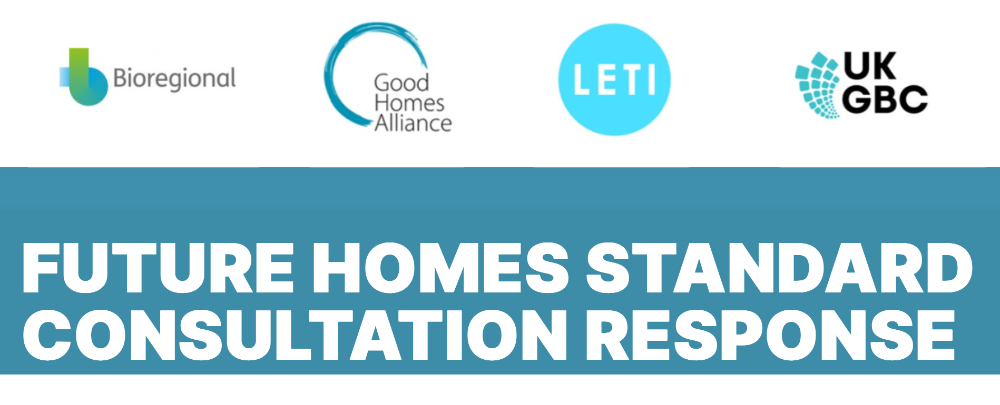Future Homes Standard: Industry calls for more ambition
In a significant demonstration of industry concern, a joint letter expressing disappointment over the proposed Future Homes and Buildings Standard has been sent to the Department for Levelling Up, Housing, and Communities (DLUHC).
Drafted collaboratively by the Good Homes Alliance (GHA) and Bioregional, in partnership with the Low Energy Transformation Initiative (LETI) and the UK Green Building Council (UKGBC) and other organisations, the letter bears the signatures of 250 prominent industry and community leaders.
Despite some positive aspects, the Future Homes Standard consultation has drawn criticism from a wide spectrum of industry organsiations. The signatories, representing a diverse array of stakeholders ranging from developers and local authorities, to consultants and architects, emphasise the imperative of a higher standard which address the pressing challenges of building the sustainable, healthy homes with low bills needed.
The unified call for action demands further collaboration to deliver a fit-for-purpose proposal, advocating for measures that prioritise energy efficiency, carbon reduction, and resilience for new build housing. Signatories urge DLUHC to engage in substantive dialogue with industry stakeholders to set out future iterations of the standard and ensure its efficacy in advancing sustainability.
Sue Riddlestone OBE, co-founder and CEO of Bioregional said
“The industry, including mainstream housebuilders, were expecting something more coherent from the government than the two options in the FHS consultation. DLUHC’s reasoning behind the proposals is that firstly, higher standards will impact housing supply. They won’t! They can be factored into training and land values. Secondly, the consultation states that it will be cheaper to decarbonise the grid, but provides no evidence, at a time when grid electricity needs to grow fourfold by 2050. There is a huge amount of goodwill and experience in the sector, we stand ready to support policymakers to create a fit for purpose FHS.”
Lynne Sullivan OBE, Chair of Good Home Alliance said
“In recent months new reports have again evidenced the poor quality of UK’s new homes but the FHS proposals fall far short of our expectations for better fabric and post construction testing, to deliver consumer confidence in solving issues of mould growth and condensation and certainty of low running costs. Aside from the switch to low carbon heating, by failing to deliver on these - and their promises to tackle embodied carbon of materials – DLUHC’s proposals for a standard fit for our 2050 goals are inadequate.”
Read the letter and see the list of signatories here https://goodhomes.org.uk/future-home- standard-response-1.
This article was issued via Press Release as "INDUSTRY LEADERS CALL FOR MORE AMBITION IN THE PROPOSED FUTURE HOMES STANDARD" dated March 27, 2024.
[edit] Related articles on Designing Buildings
- BRE Group response to the Future Homes Standard consultation.
- Building Better, Building Beautiful Commission.
- Changes to Building Regulations Part F.
- Consortium issues urgent call for more ambitious Future Homes Standard.
- Getting zero carbon done.
- Future Buildings Standard.
- Future Homes Standard consultations.
- Future Buildings Standard shortcomings raised.
- Green Housing Revolution.
- Home design prospects under the Future Homes Standard.
- Home Energy Model.
- Hybrid heat pump electric panel heating.
- Is hydrogen the heating fuel of the future?
- National Design Guide.
- Pilot programme for National Model Design Code NMDC.
- The Home Energy Model and Future Homes Standard assessment wrapper.
- Thermal bridging and the Future Homes Standard.
Featured articles and news
OpenUSD possibilities: Look before you leap
Being ready for the OpenUSD solutions set to transform architecture and design.
Global Asbestos Awareness Week 2025
Highlighting the continuing threat to trades persons.
Retrofit of Buildings, a CIOB Technical Publication
Now available in Arabic and Chinese aswell as English.
The context, schemes, standards, roles and relevance of the Building Safety Act.
Retrofit 25 – What's Stopping Us?
Exhibition Opens at The Building Centre.
Types of work to existing buildings
A simple circular economy wiki breakdown with further links.
A threat to the creativity that makes London special.
How can digital twins boost profitability within construction?
The smart construction dashboard, as-built data and site changes forming an accurate digital twin.
Unlocking surplus public defence land and more to speed up the delivery of housing.
The Planning and Infrastructure Bill
An outline of the bill with a mix of reactions on potential impacts from IHBC, CIEEM, CIC, ACE and EIC.
Farnborough College Unveils its Half-house for Sustainable Construction Training.
Spring Statement 2025 with reactions from industry
Confirming previously announced funding, and welfare changes amid adjusted growth forecast.
Scottish Government responds to Grenfell report
As fund for unsafe cladding assessments is launched.
CLC and BSR process map for HRB approvals
One of the initial outputs of their weekly BSR meetings.
Building Safety Levy technical consultation response
Details of the planned levy now due in 2026.
Great British Energy install solar on school and NHS sites
200 schools and 200 NHS sites to get solar systems, as first project of the newly formed government initiative.
600 million for 60,000 more skilled construction workers
Announced by Treasury ahead of the Spring Statement.
























